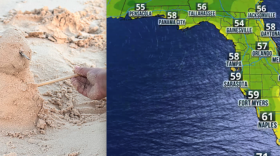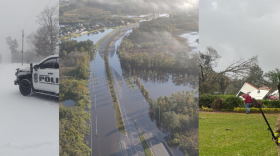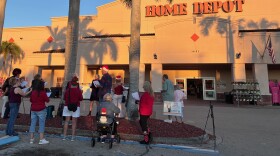WATER QUALITY REPORT FOR DEC. 17, 2023
Eight of the nine species of turtle, frog, bird, and the like, that inhabit Sanibel and Captiva islands either made it through Hurricane Ian or made its back to the islands during the last year-plus.
But missing in action to this day is the pig frog, better known as the Southwest Florida’s famed bullfrog.
The champion grunter of all frogs, the noise it makes is between a pig and an alligator bellowing for a mate. And pig frogs rarely grunt alone, although on Sanibel and Captiva the chorus of pig frogs is silent.
This past summer, when the deep, choral grunt of the large pig frog community was normally repeated two or three times there was only the sound …. of silence.
“Unfortunately, this noise has not been documented since Hurricane Ian,” said Chris Lechowicz, the Sanibel-Captiva Conservation Foundation’s director of wildlife and habitat management. “Although we still have hope that this species remains on the island, there is a possibility that we may have lost them to the storm.”
Pig frogs were released in the J.N. “Ding” Darling National Wildlife Refuge in the 1950s. They had not been documented previously on Sanibel, but it turned out to be a great match.
The island offered a great freshwater source that was augmented by the modification of the Sanibel River that hopscotches along the eastern end of the island. During the last several decades the choral grunt of the pig frog became a nightly performance island residents enjoyed, or not.

At this point, please allow me a moment to tell a short tale from my previous time on a different part of this planet to discuss another creature that is impossibly loud for its size.
Stay with me. You’ll get a kick out of this.
Quite a while ago, my friend and I went to Costa Rica. We climbed up an active volcano, went to Montezuma and avoided the revenge, and spent more days than we planned on a then-deserted beach called Manuel Antonio.
In each place we encountered howler monkeys, which are just a few feet tall but sound like King Kong. Coming for you. With friends.
The first time I heard what one of them can do — and why they are named howlers — was the day I was climbing up the volcano, which was within a canyon. A howler monkey let it rip.
The deep, angry, bass of its strong voice echoed back and forth off the canyon walls for what seemed like a minute. Scared the absolute everything out of me.
“Dude! Do we need to run?”, I said to my buddy, who had been there before. “We do need to run, right?” He laughed at me and told me to — quote — “shut your pie hole. We’re fine.”
I heard my second howler monkey at Manny and Tony’s — that’s what the locals called the deserted beach — and despite no ricocheting howl it still left me unsettled. I mean, what if a creature of that size found us on the beach all alone?
“What little remained of two American tourists was found on a remote beach along the Pacific Coast of Costa Rica …”
We came across the third howler monkey early one morning in Montezuma. We rented a yurt, and at dawn, many animals were puttering on the roof. Skittering. Sliding. Shuffling. Every jungle animal horror movie ran through my head.
In time, I went out and hoisted myself up to look at the roof. The first animal I see is a three-foot lizard, like a monitor, which explains the skittering, The second animal I saw? No idea, but the way it moved explained the sliding sound.
Third was the cutest little money, just shuffling around like a tiny person with nothing particular to do. Then it locked eyes with me, and started to form a perfect oval with its mouth: IT WAS A HOWLER MONKEY! ON THE ROOF OF MY YURT!
So “King Kong” was about two feet tall. But I knew what it could do. I slowly lowered myself down to the ground, went back into the yurt, and covered my ears with pillows. The howler monkey, apparently from a quieter clan, just left.
Back to our dear pig frog, with its outsized grunts, scale-wise, on par with the howler monkeys of Central America.
Pig frogs are the most hunted in Florida. Frog’s legs, anyone?
In turn, the pig frog is a hunter itself and it will eat anything it can swallow, including dragonflies, crayfish, beetles, aquatic bugs — and other frogs. Females lay their eggs — as many as 10,000 of them — in a film on water from April through August.
Throughout Sanibel’s 6000-year history the island likely had small populations of pig frogs, but periodic storm surge events wiped them out as may have happened during Hurricane Ian.
Again and again, pig frogs have made their way to the island on floating mats of vegetation, which is how many species arrived and colonized the island.
“We are hoping the same is true with these magnificent frogs,” Lechowicz said.
RED TIDE
The red tide organism, Karenia brevis, was not observed in samples collected statewide over the past week.
No reports of fish kills suspected to be related to red tide were received over the past week.
Respiratory irritation was not reported in Florida over the past week. one.
BLUE-GREEN ALGAE
There were 18 reported site visits by the Florida Department of Environmental Protection in the past seven days with 18 samples collected. Algal bloom conditions were observed by samplers at three of the sites, but none were in Southwest Florida.
The best available satellite imagery for Lake Okeechobee from Dec. 12 is partially obscured by cloud cover, but it shows scattered low-to-moderate bloom potential in visible portions of the lake, primarily on the western half.
The best available satellite imagery for the Caloosahatchee Estuary is also from Dec 12, and it shows very scattered moderate bloom potential on visible portions of the estuary.
The FDEP says it is important to remember the blue-green algae potential is subject to change due to rapidly changing environmental conditions or satellite inconsistencies.
What is red tide?
Red tide is one type of harmful algal bloom caused by high concentrations of the toxic dinoflagellate K. brevis, which is a type of microscopic algae found in the Gulf of Mexico. Red tide typically forms naturally offshore, commonly in late summer or early fall, and is carried into coastal waters by winds and currents. Once inshore, these opportunistic organisms can use nearshore nutrient sources to fuel their growth. Blooms typically last into winter or spring, but in some cases, can endure for more than one year.
Is red tide harmful?
K. brevis produces potent neurotoxins (brevetoxins) that can be harmful to the health of both wildlife and people. Wind and wave action can break open K. brevis cells and release toxins into the air. This is why you should monitor conditions and stay away from beaches where red tide is in bloom. People in coastal areas can experience varying degrees of eye, nose and throat irritation during a red tide bloom. Some individuals with chronic respiratory conditions like asthma or chronic lung disease might experience more severe symptoms. Red tide toxins can also affect the central nervous system of fish and other marine life, which can lead to fish kills.
What causes red tide?
A red tide bloom develops naturally, but recent studies have discovered mankind's infusion of other nutrients into the mix can make the red tide last longer or get stronger. But biology (the organisms), chemistry (natural or man-made nutrients for growth) and physics (concentrating and transport mechanisms) interact to produce the algal bloom. No one factor causes the development of a red tide bloom.
What is blue-green algae?
Blue-green algae, also known as cyanobacteria, are a group of organisms that can live in freshwater, saltwater or brackish water. Large concentrations, called blooms, can change the water color to blue, green, brown, orange or red. Some cyanobacterial blooms can look like foam, scum, or mats on the surface of freshwater lakes and ponds. As algae in a cyanobacterial bloom die, the water may smell bad
Is blue-green algae harmful?
Different types of blue-green algal bloom species can look different and have different impacts. However, regardless of species, many types of blue-green algae can produce toxins that can make you or your pets sick if swallowed or possibly cause skin and eye irritation. The Florida Department of Environmental Protection advises staying out of water where algae is visibly present as specks or mats or where water is discolored. Pets or livestock should not come into contact with algal bloom-impacted water or with algal bloom material or fish on the shoreline. If they do, wash the animals immediately.
What causes blue-green algae?
Blue-green algae blooms occur when the algae that are normally present grow in numbers more than normal. Within a few days, a bloom can cause clear water to become cloudy. Winds tend to push some floating blooms to the shore where they become more noticeable. Cyanobacterial blooms can form in warm, slow-moving waters that are rich in nutrients. Blooms can occur at any time, but most often occur in late summer or early fall.
If any major type of water quality alert is issued, you can find the details here in WGCU’s Water Quality Report.
Environmental reporting for WGCU is funded in part by VoLo Foundation, a non-profit with a mission to accelerate change and global impact by supporting science-based climate solutions, enhancing education, and improving health.
Sign up for WGCU's monthly environmental newsletter, the Green Flash, today.
WGCU is your trusted source for news and information in Southwest Florida. We are a nonprofit public service, and your support is more critical than ever. Keep public media strong and donate now. Thank you.








